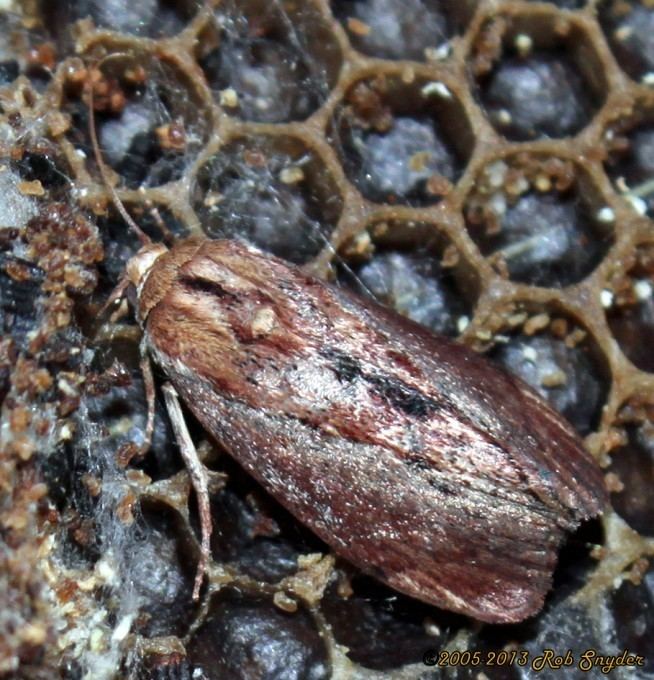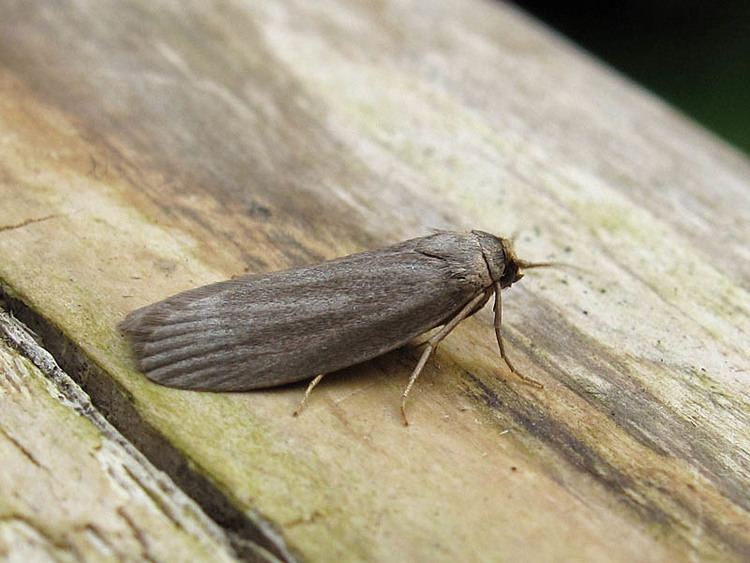Kingdom Animalia Order Lepidoptera Family Pyralidae Scientific name Achroia grisella Rank Species | Phylum Arthropoda Division Ditrysia Tribe Galleriini Higher classification Achroia | |
 | ||
Similar Galleria mellonella, Insect, Achroia, Small hive beetle, Butterflies and moths | ||
Achroia grisella, the lesser wax moth, is a small moth of the snout moth family (Pyralidae), wherein it belongs to the subfamily Galleriinae. It is the only unequivocally recognized species of genus Achroia. The Greater Wax Moth (Galleria mellonella) is a quite close relative; though placed in a distinct genus, it still belongs to the same tribe – the Galleriini – within the Galleriinae.
Contents
Their caterpillars larvae are among the best-known "waxworms", as they are widely bred as food for pets such as lizards or fish.

Lesser wax moths are very common in most parts of the world, except the colder regions, aided in their spread by humans who have involuntarily introduced them to many countries. They are known or suspected to inhabit most of Africa (including Madagascar), Australia, Europe (expect perhaps some more remote regions, particularly in Greece) and North America, as well as parts of the Neotropics (at least Colombia, Jamaica, Puerto Rico and Trinidad), the Bengal region, Japan, Sri Lanka, and the Marquesas Islands and Tahiti in French Polynesia.

Ecology

The lesser wax moth typically resides in milder climates, but can be prevalent in areas such as Florida because of the year-round warm climate. These moths live around 7 months, from egg to senile adult. They go through four stages in their life cycle – egg, larva (caterpillar), pupa and imago – like all holometabolous insects.

The larvae are the only ones that eat; the adults will not. Their diet typically consists of honey, beeswax, stored pollen, bee shell casings, and in some cases bee brood. Tunneling through honeycombs will not only provide food, but also protect the larvae from the defending worker bees. Less usual foods that have been reported are dried vegetable remains, dried fruits (especially apples and raisins), horn shavings (an organic fertilizer), cork and even refined sugar. They will also burrow into soft wood.
Populations of these moths take over the honeycombs of bee colonies, usually when the bees are in a weakened state. Lesser Wax Moths can often be seen in bee colonies trying to lay their eggs, but in most cases the worker bees will eliminate them and keep the moths from over-running the colony. When the colony is going through a period of stress, such as after the loss of its queen bee or under starvation conditions, the moths may completely take over the honeycombs.
The reproduction of these moths begins with ultrasonic signals sent out by the males in order to attract their female partners. The typical mating spot for these moths is in honeybee colonies, and the males can be seen there anywhere between six and ten hours in just a single night. Females are attracted to these ultrasonic signals in any one of three ways; peak amplitude, signal rate, and the asynchrony interval. Studies have been conducted that show these moths increase their signal rate when having to compete with others for the right to a local female, but due to the physical demands of an increased signal rate, its duration typically lasts only five to ten minutes. It has been concluded that these are the most prevalent few minutes of the entire six to ten hours spent out each night.
Control
The caterpillars of the lesser wax moth can be very destructive to the honeycomb. They were first seen in North America in 1806, and are believed to have been imported there with honeybees from Europe. It has been estimated that annually, beekeepers lose nearly 5 million US dollars in damages due to these pests. There are many methods of control that beekeepers have adopted to ensure that these moths do not ruin the combs.
The bees themselves are the best form of control for these moths. They keep the populations at very low numbers and it is only when they are not strong enough that the moth populations will drastically increase. Beekeepers must make sure that the hives have active, populated colonies that are clean and free of debris. This will help to ensure the survival and strength of the bees who can then control the populations of the moths.
In the colder climates, storing the beeswax combs in freezing winter temperatures will stop there from being any chance of a moth infestation. Lesser wax moths need warm climates to thrive. There is also a fumigant known as paradichlorobenzene (PDB) that is used to destroy these moths. This can only be used on combs that are in storage. They are not successful on combs that currently are filled with honey. Carbon dioxide can be used to fumigate combs that are filled with honey. It ensures that the honey is still acceptable to be sold.
Heating or freezing combs filled with honey also allow the honey to still be sold. The hotter or colder the temperature is, the less time that is required to make sure that the comb has been protected.
So far no traps have been found that completely protect honeycombs from the invasion of lesser wax moth larva.
